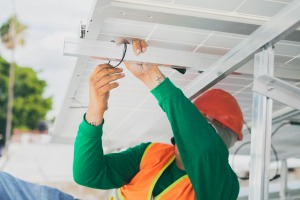

Market report
Blogs I published 22 July 2025 I Dirk Hoogenboom
The New Rules for Reaching Electrical Installers in 2025
Looking at any electrical wholesaler in Europe right now, there’s a few printed catalogs on the counter ready to be skimmed, sure – but what are the installers actually doing? Texting reps, checking specs on their phones, blitzing QR codes on packaging, watching install videos on YouTube… definitely placing orders through WhatsApp.
This isn’t anecdotal – it’s structural. Installers across Europe are shifting how they find, trust and act on product information. The channels they rely on are faster, more digital and more direct than they were five years ago… even two years ago. Meanwhile, manufacturers and wholesalers are investing in a mix of trade magazines, flyers and product microsites, and fingers crossed something sticks. In other words, media that no longer delivers results.
So if your marketing strategy is print catalogs, trade magazine ads or hoping someone scrolls through your website to find a downloadable PDF, you’re out of sync with how your audience lives and works. Here’s what you need to know and what you need to do.
WhatsApp Isn’t a Trend – It’s Infrastructure
Think about it: installers are mobile professionals. When they need specs, answers or support, they need it fast and on their phone – no logins, no waiting on hold. That’s why WhatsApp has become a default tool across Europe. It gets them what they need, when they actually need it. Here’s the data:
- 63% of installers in Europe use WhatsApp or similar messaging apps daily for work
- Some 46% use it to communicate with wholesalers, and 43% use it to talk directly to manufacturers
- In Spain, that daily usage hits 75% and 64%, while the Netherlands hits 56% and 41%
- in both markets, it’s become embedded in day-to-day operations
This isn’t just convenience, but a default for field communication. If your support team isn’t available via WhatsApp or a comparable platform, you’re effectively introducing friction into your buyer’s workday. So it’s generally good to stop treating WhatsApp like a social app. Build dedicated workflows for order inquiries, tech support, product documentation and stock availability. Turn it into a frontline service channel.
Installers Are Looking for Spec Sheets
Installers don’t Google company names. They type exact, technical queries like “3-phase DIN rail contactor datasheet” or “LED driver 24V dimmable wiring diagram.” They want specs, wiring diagrams, installation guides instead of marketing fluff, trends or buzzwords.
The numbers tell the story:
- 96% of installers use Google to find product info
- 94% visit manufacturer websites, but only if they find what they want immediately
- the #1 content installers want – technical specs, followed closely by installation guides and pricing
Nobody’s browsing or window shopping. This is high-urgency, task-oriented digital behavior – they need answers and precision, so they want answers in seconds, not minutes.
The action plan is auditing your website. It is not a brochure. It’s a tool your customers use to get their job done. You need structured and easy-to-find product data, fast loading speeds, mobile-first UE and SEO tweaks that match exact product-level keywords, not corporate jargon. Think like your customer: “Can I find this in 15 seconds or less?” If an installer can’t, you’re losing to whoever is faster.
Apps Should Save Time
Europe’s electricians are using more digital tools than ever, but they’re not interested in shiny apps with vague functionality. They want utility, speed and clear ROI. Otherwise, uninstaller software is fired up, and it’s off to find a new app.
Apps and digital tool usage is particularly high in Germany (91%) and Sweden (87%), and we see manufacturer apps outperforming third-party ones, but only when they solve actual problems.
What works best? Product lookup by code or name. On-site installation help. Stock checking across distributors. Built-in calculators for load, wiring or compliance. What doesn’t work at all? “Marketing-first” that buries functionality.
I.e. – don’t build an app for engagement purposes. Build an app that gets used. If it isn’t time-saving, or meant for on-site utility, it’s ignored by Wednesday and uninstalled by Friday.
Print Media Has a Pulse in Certain Markets
We’ve seen a steady decline of traditional media channels for years now, but dead would definitely be the wrong word. Print still matters in specific regions and demographics, especially among installers over 45.
Case in point – in Germany, 78% of installers say printed materials are still important, and their French, English and Belgian peers agree. If we instead look at the Netherlands, Denmark or Sweden, print use has sharply declined. This divide has a geographical and generational background.
Older professionals want printed catalogs, technical handbooks, even trade magazines. Younger installers would rather check a digital app, scroll a YouTube how-to or ping a support rep on WhatsApp.
The best course of action would be segmenting your collateral by market maturity. Use print strategically – targeted catalog drops, leave-behind technical manuals or regional trade magazine placements; and only in markets where it still carries authority. Everywhere else? Go digital. You’ll feel the tide coming in.
Social Media is Rising, But Not in All Channels
There’s a general tendency to lump social media together into a single box that effectively neutralizes very tangible differences among channels. Even when they are sharp and functional.
Younger installers (the under 45s) use Instagram, YouTube and Facebook for product discovery. They actively check out how-to content and visual product explanations. They investigate tools and trends that show up in their feed, getting sharper and more informed by the scroll. Older installers, however, lean more on familiar, trusted, traditional media. LinkedIn and other social platforms are avoided entirely, or to the most possible extent.
You should tailor socials depending on the message and audience. Showing off a new product feature? Try with a 30-second vertical video on Instagram. Want to provide install instructions? Use YouTube. Trying to win hearts with corporate brand stories? Facebook won’t get you far anymore.
Installers Are Segmenting
Here’s the biggest takeaway from the entire report – there is no single “installer persona” anymore.
Younger, digital-native electricians behave differently than legacy professionals. Mid-size firms operate differently from one-man bands. Germany is not Denmark. If you’re running a communication that tries speaking to everyone, you’re essentially not speaking to anyone. So use data to break your audience into real behavioral groups, align messaging and channel to their habits – not your assumptions – and measure what matters (say, time-to-support, download volume, app engagement, instead of vanity metrics).
Think like a smart product manager. Build user journeys. Define personas based on data. Then deploy the right content, in the right format, on the right platform, at the right moment in their workflow.
Conclusion
Electricians are practical people. If your content, app, support or sales funnel isn’t solving a problem or saving time, it’s an effective liability. You don’t need more budget. You need better precision.
The winners in this space will be the companies who act like partners, not advertisers. Who use digital not to be trendy, but to be helpful. Who recognize that WhatsApp is a business tool, not a gimmick. That Google is your storefront. That your app is a wrench, not a billboard.
Because we’re not really talking about futureproofing – this is how the work is already getting done. So stop writing more brochures and meet your customers where they are. Want to know how? Get in touch. We have in-depth reports, practical webinars and specialized tools to get you where you want to be.





